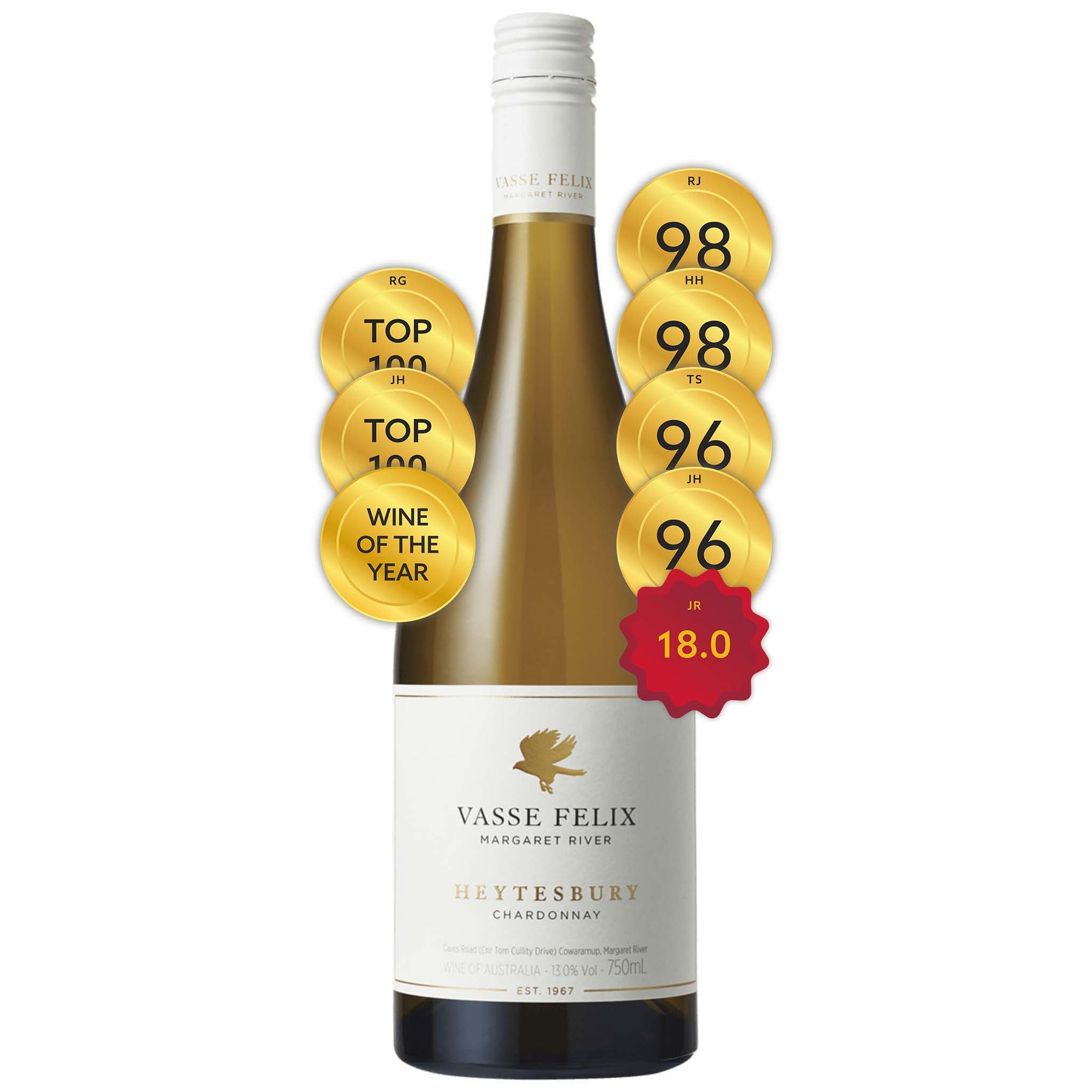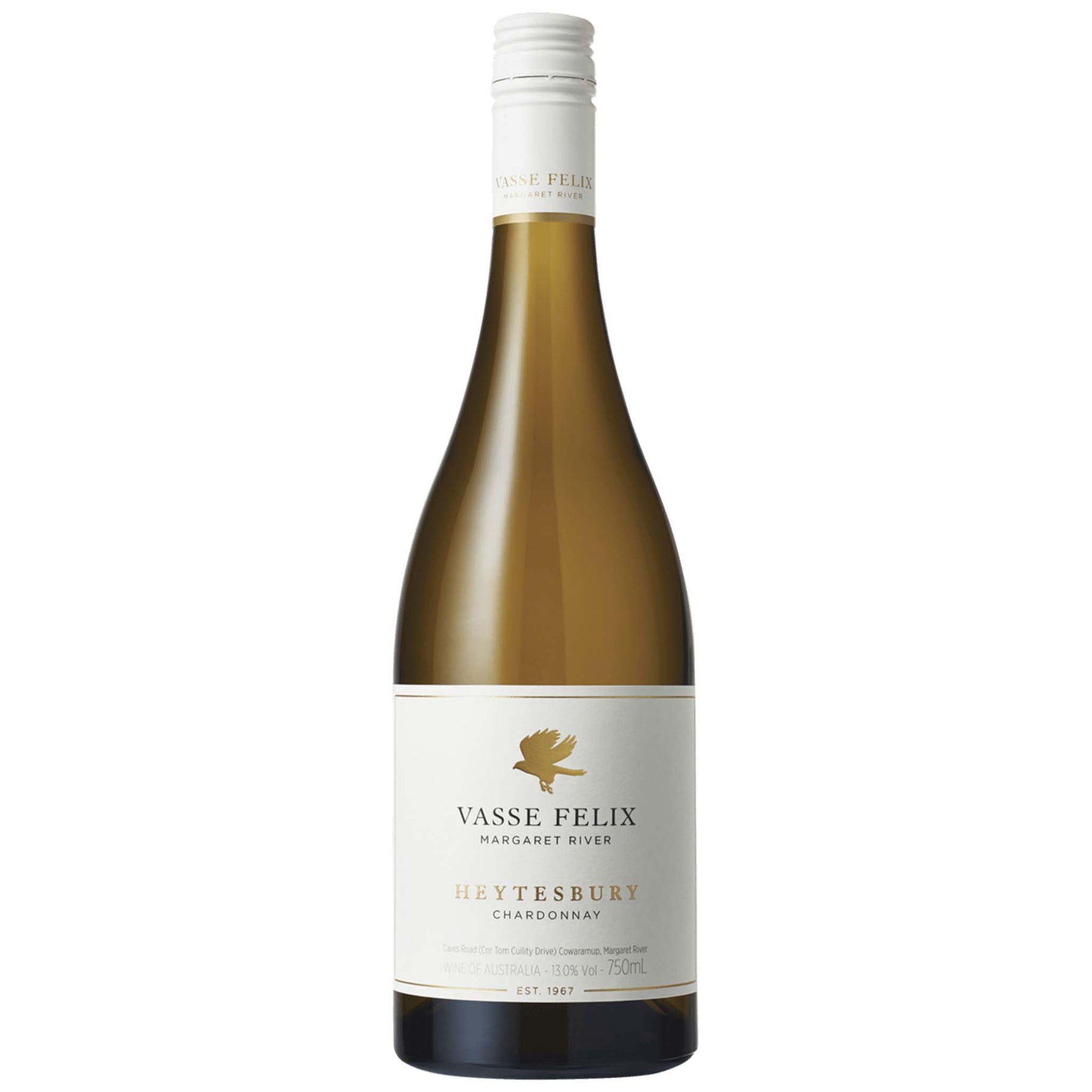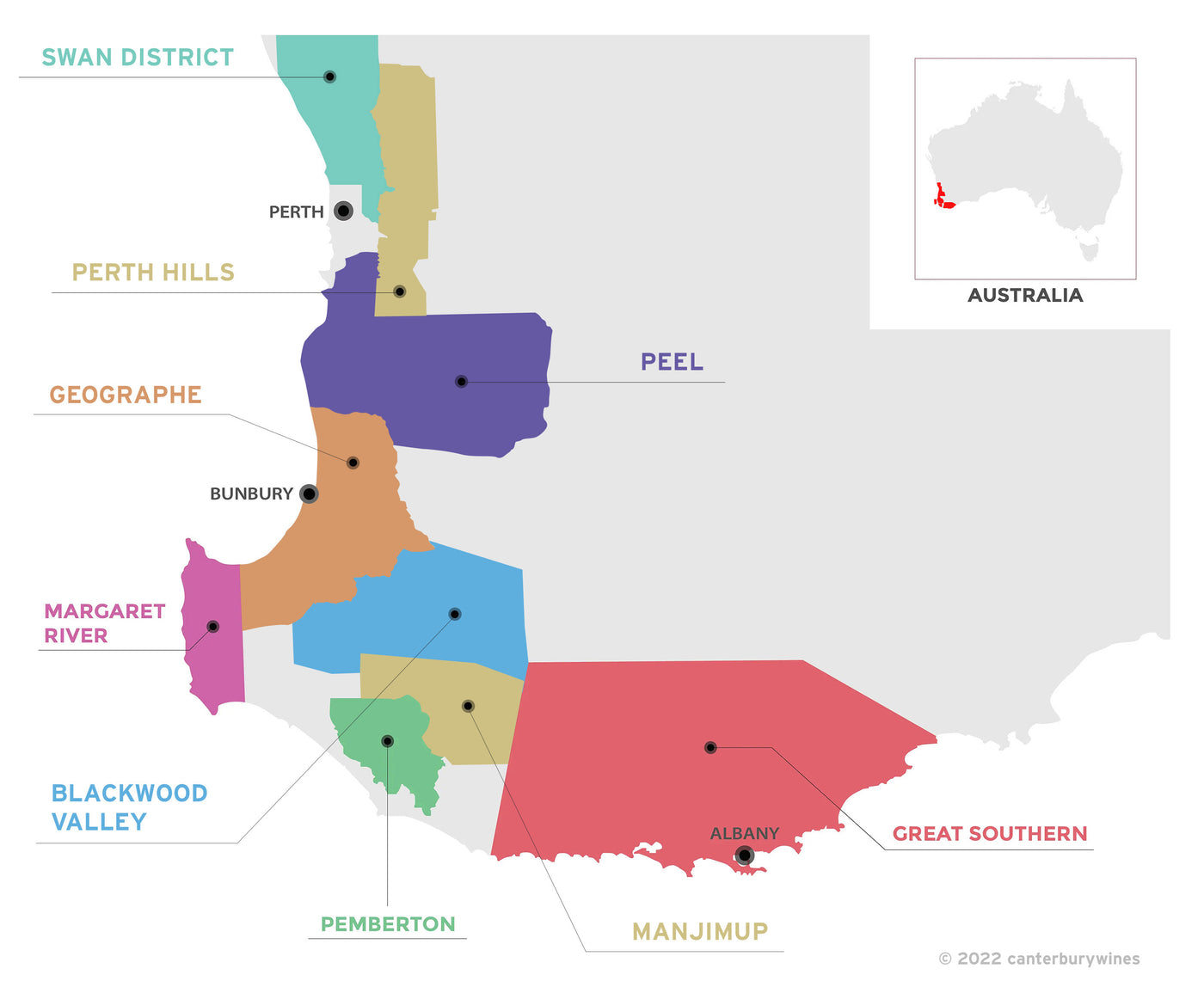

Vasse Felix Heytesbury Chardonnay 2011
Style: White Wine
Closure: Screwcap
Vasse Felix Heytesbury Chardonnay 2011
Warehouse
34 Redland Drive
Vermont VIC 3133
Australia
Critic Score: 98 and 18/20
Alcohol: 13.0%
Size: 750 ml
Drink by: Now
Ray Jordan Wine of the Year 2012
James Halliday Top 100 Wines of 2012
Rob Geddes Top 100 Wines of 2012
Vasse Felix, Margaret River’s founding wine estate, is one of the heavyweights of Australian wine. The first Chardonnay under the flagship Heytesbury label was made in 1996, but it was the arrival of Virginia Willcock as Chief Winemaker in 2006 that helped it become a benchmark Australian Chardonnay. The wine quickly became a sensation on the wine show circuit; the 2009 vintage was a triple trophy winner at the 2010 Australian National Wine Show, followed by the 2010 which won 11 trophies in total, to become one of the most awarded Chardonnays in Australian history.
"Taut, refined, intense flavour, tightly knit and still very reserved and needing time. Delicious palate flavours with hints of 'lemon butter' and stone fruits. Already has a lot of complexity and is quite open, surprisingly. An outstanding wine, with more to reveal in future." Huon Hooke
"Bright pale straw with a green tinge. A complex and powerful perfume. Bursting with fragrant pineapple and lemon freshness, the nose gently releases its cache of wild barrel ferment characters. Crusty apple pie, pretty lavender, struck stone flintiness, plus subtle lamb fat and bay leaf provide shadow and depth to the bright citrus that shines from the core. Intricate, luscious and mouth-watering, reflecting pineapple, custard apple and water chestnut, lightly spiced with cloves, vanillan oak and almond biscuit flavours. Opens with juicy fruit and evolves to a tight acid drying finish, that carries the pristine and complex flavours for remarkable length.
A barrel selection of the very best Chardonnay parcels from the vintage. It was fermented entirely with wild yeasts and matured in French oak barriques with battonage for nine months. Our style of Chardonnay has developed significantly over recent years with complex vineyard character coming from less clarified juice and natural yeast." Vasse Felix
Expert reviews
"A mighty follow up to the sensational 2010 which took all before it on the show circuit. This is not so obvious but in some ways is a superior wine.. by a bit. Carries the aromatic same mix of cereal and grapefruit, with the fine minerally thread a striking feature. Such perfect balance and poise on the palate with the fine delicate flavours held through to a long penetrating finish. Great stuff." Ray Jordan, The West Australian – 98 points and Wine of the Year 2012
"Light straw yellow colour. Restrained aromas with lots of mineral notes dominant. Taut, refined, intense flavour, tightly knit and still very reserved and needing time. Delicious palate flavours with hints of 'lemon butter' and stone fruits. Already has a lot of complexity and is quite open, surprisingly. An outstanding wine, with more to reveal in future." Huon Hooke, The Real Review – 98 points
Rob Geddes Top 100 Wines of 2012, Australian Wine Vintages
"Bright straw-green; has the poised elegance that has become the hallmark of Vasse Felix Heytesbury Chardonnay, every component finely detailed and in balance with every other component; it is driven by its stone fruit in the first instance, but with oak and acidity also contributing to the texture and complexity of the wine. Drink by 2021." James Halliday, Halliday Wine Companion - 96 points and Top 100 Wines of 2012
"Smoky and toasty and a bit of struck match reduction - gives the high note. Lots of lime fruit underneath but definitely not a fruit-forward wine. Leaner fruit than the 2010 but full in the mouth with all that texture and weight. Fabulous freshness and length. Great concentration. Drink 2015-2025." Julia Harding MW, jancisrobinson.com – 18/20 points
"Heytesbury is a more profound expression of the direction of modern Margaret River chardonnay than perhaps any other, capturing the fruit power of the region and encasing it in high-tensile structure, overlaid with funky gunflint and sulphide notes. This is winemaking on the edge: massive volumes of solids in the ferment, wild yeast and more new oak than ever. The result of this maelstrom is profound: at once chiselled, brittle and cracking and at the same time resonating with low notes of funky, savoury complexity. Its taut acidity bursts through the finish, defining a tense frame of tangy, lemon-infused persistence and soft, finely-crafted mineral texture." Tyson Stelzer – 96 points
"The 2010 Heytesbury, an epic example of modern Australian Chardonnay, bagged no less than 11 trophies on the Australian wine show circuit. The 2011 is no less compelling, shoehorning, as it does, Margaret River's intensely concentrated fruit and citric backbone into an ever so-tightly framed package. On the nose it shows lemon powder puff, kaffir lime and cedary vanillin oak which follow through on a palate whose steely charge of grapefruity acidity fair whisks you off you feet. Along the journey, fleshier notes of creamy custard apple and white peach tantalise though, save for traces of dried honey, the long finish has a Chabliseque bone dry austerity, even on day two. Most definitely a wine to squirrel away for a couple of years &, no doubt, enjoy over several years, maybe more. As they say, the face of modern Australian Chardonnay." Sarah Ahmed, The Wine Detective UK
Awards
Ray Jordan Wine of the Year 2012
James Halliday Top 100 Wines of 2012
Rob Geddes Top 100 Wines of 2012
Virginia Willcock

Virginia Willcock is a prodigious talent who has been instrumental in taking the fortunes of Vasse Felix, a heavyweight in Australian wine and Margaret River’s founding wine estate, to the next level. Willcock joined Vasse Felix as Chief Winemaker in October 2006, is still there today, and believes her best wine is still to come.
To date Virginia has completed over 30 vintages in Margaret River, which makes her a respected authority on Margaret River and its terroir. In addition, she has also spent time abroad doing international vintages in Albania, Italy (Trentino, Sicily and Abruzzo) and New Zealand.
Virginia is one of the most awarded female winemakers in Australia, having been named 'Gourmet Traveller WINE Australian Winemaker of the Year' in 2012, 'Winemaker of the Year' by The West Australian Good Wine Guide 2013, and 'Winemaker of the Year' in the 2017 Australian Women in Wine Awards. Virginia was also nominated as 'Winemaker of the Year' in Wine Enthusiast Magazine 2014 Awards and 'Winemaker of the Year' in the ASVO (Australian Society of Viticulture and Oenology) Award for Excellence 2016.
Despite her success, Virginia’s not taking her foot off the accelerator. And she’s constantly learning about the region she loves. "My winemaking has become more about a natural expression from a piece of ground," she says, "and every tiny piece of ground with every [grape] clone and variety behave differently. There’s amazing little personalities that come through that I’ve been able to discover."

Click on image to play video
The article below by Alana House appeared in https://www.drinkstrade.com.au/
Virginia Willcock, winner of Winemaker of the Year at the 2017 Australian Women in Wine Awards (AWIWA), talks to Ray Ruano about following her passion and the challenges of winemaking.
For more than a decade, Virginia Willcock has been spreading the word about the unique, thriving Margaret River region, which has helped shape Vasse Felix into the thriving, global wine estate it is today.
Vasse Felix is celebrating its 50th birthday this year (2017) and was recently rated the best new world winery in the world by US wine publication Wine Enthusiast.
As a respected authority on Margaret River winemaking, Wilcock has represented the unique region through media and trade conventions and as a wine show judge, while completing almost 25 vintages in Margaret River.
Her journey to becoming a winemaker
From the age of 15, Willcock knew the world of winemaking was for her.
"My parents had a little vineyard, north of Perth and one day my dad came home one day and said 'You can study winemaking' and I went 'Wow! That’s exactly what I want to do'," Willcock recalls.
She went on to study winemaking at Roseworthy Agricultural College, which is now a part of the University of Adelaide.
"I loved the idea of growing fruit, and then turning it into something that could be more beautiful and would give people a lot of enjoyment," Willcock noted in a Vasse Felix’s biography.
Throughout her career, Willcock has gained extensive knowledge and experience from her travels on winemaking and the importance of wine regions in regards to the history of the land, soil and air.
She told Wine Australia: "My grape and wine philosophy is a beautiful natural expression of a place… When I smell the forest, smell the ocean, smell the beautiful dirt, I want to see some of that come through in the wine in a natural, earthy, rustic sense."
During her travels through vineyards, she has developed a passion for Cabernet Sauvignon, which is Margaret River’s best performing wine varietal.
Her love of Margaret River, home to Vasse Felix
Located south of Perth, the Margaret River provides a Mediterranean climate that makes it an ideal region for growing grapes and fine wine.
"I am blessed because Margaret River is such a great place to grow grapes, so that makes my job easier," Willcock admits with delight.
She believes that the Margaret River region is one of the greatest in the world as the wines continue to strive to reach their full potential.
"I wouldn’t want to be making wine anywhere else!"
Her passion and best advice
Willcock shared that it is important to have passion for what you do in life.
"You gotta be driven by your passion," she said: I think that if you’re passionate about something, you will always do really well because you love it. I think it’s the love for [winemaking] that has given me that drive to work as hard as you have to as a winemaker."
When asked what advice she would have given herself at the start of her career in wine, she said: "Get some practical experience before you study."
Although her family owned a vineyard, she admits she never participated in any of the winemaking
"Operating pumps, winery equipment, and just understanding what the processes are, from start to finish [is important]."
Life as a winemaker and the challenges of winemaking
As for the most rewarding part of being a winemaker, Willcock simply said: "I think it’s creating something new every year, something that is new and beautiful that represents that year, the conditions, and the place that you’re from."
She makes it clear that because you only get one chance every year, so you cannot "stuff it up".
"There’s an immense satisfaction in finding the best of what you can do on an annual basis," she said.
The winemaking process is a very important one as several decisions go into perfecting a bottle. For Willcock, the decision-making is a special aspect of winemaking.
"A number of decisions are made for every grape batch, when to harvest them, [and] how they will flow in the winery and eventually in the bottle." Willcock said. "Two hundred decisions are made for every little batch of wine. The decision not to do something is just as important as the decision to do something."
Willcock shared that having an intimate understanding of the land and where the grapes are grown is a challenge.
"Understanding the things that make [the land] different and being able to respond to that [is key] because it’s all about nature." Willcock said. "Nature delivers, and you just have to nurture it."
About the winery

Vasse Felix was the first commercial vineyard and winery to be established in the Margaret River region of Western Australia. In 1965 Dr John Gladstones emphasised the region's suitability in his report ‘The Climate and Soils of Southern WA in relation to Vine Growing’. Two years later Dr Tom Cullity planted vines and Vasse Felix was born..
Tom was a cardiologist working in Perth when he decided to turn his hand to growing grapes. He searched obsessively for the perfect plot of land, taking guidance from the research of John Gladstones (1965), looking for 'red gravel in redgum country, with clay about 18 inches below the surface.' He eventually settled on an 8 acre piece of land near Caves Road by the Wilyabrup Brook which he purchased for the princely sum of $75 an acre! Among his first plantings of Cabernet Sauvignon and Malbec vines was what we now refer to as Houghton clone Cabernet Sauvignon, the core of Margaret River’s finest Cabernets. This original plot of land now forms part of the Vasse Felix Home Vineyard which has been expanded over time to 52 hectares in size.
Tom used to drive down on the gravel roads from Perth to Margaret River after the working week to nurture his young vine plantings, work all weekend, before heading back to his 'day job' late on Sunday afternoons. Tom is quoted as saying of this period: “Much of the time, in different ways, I was on my own. I knew nothing except what I had read in books. There was no local source of basic equipment. Quite a lot of the local farmers must have thought it was a joke.”
In 1984, not long after retiring as a doctor, Tom Cullity sold Vasse Felix to David and Anne Gregg, who in turn sold to the Holmes Court family in 1987. Paul Holmes à Court is the current owner and Chief Executive Officer.
Vasse Felix’s range of wines includes Cabernet Sauvignon, Chardonnay, Shiraz and Sauvignon Blanc/Semillon blends, with the major focus on Cabernet and Chardonnay, the strengths of Margaret River. Grapes are sourced from three Margaret River vineyards; the Home vineyard, Gnarawary vineyard and Adams Road vineyard.
Home Vineyard
The original Vasse Felix vineyard planted by Dr Tom Cullity in 1967 and the site of Margaret River’s oldest vines, with careful expansion made over time. The vineyard is home to Vasse Felix’s winemaking facility where all Vasse Felix wines are made and bottled, as well as the Vasse Felix Cellar Door and Restaurant. Located just 4km from the ocean, the Wilyabrup ridge elevation offers enhanced sea breeze exposure and lean, well-draining gravel loam soils suited to Cabernet Sauvignon and Chardonnay. Grows fruit for the Icon and Premier wines.
First Planted: 1967
Soils: Gravel loam over clay
Sub-region: Wilyabrup
Altitude Range: 80 - 110 m
Total Area Under Vine: 52 ha
Gnarawary Vineyard
The Gnarawary blocks of this vineyard became part of the Vasse Felix Estate in 2015. Located centrally within the Margaret River Wine Region and experiencing cooler conditions to the Home Vineyard, this site’s free-draining lateritic gravel and moderate climate create an ideal environment for Chardonnay, Shiraz and Sauvignon Blanc. Grows fruit for the Icon and Premier wines and Alternative Collection wines.
First Planted: 1997
Soils: Gravel and sandy loam over clay
Sub-region: Wallcliffe
Altitude Range: 75 - 95 m
Total Area Under Vine: 93 ha
Adams Road Vineyard
The largest of all the Vasse Felix vineyards, this site was planted in 1998 in the warmer, Carbunup area of Margaret River. The vineyard grows fruit with ripeness, approachability and generosity of flavour, ideal for Vasse Felix’s Regional (Filius) wines and all-occasions Classic Collection wines.
First Planted: 1998
Soils: Deep red to sandy loam, gravel and clay in areas
Sub-region: Carbunup
Altitude Range: 35 - 45 m
Total Area Under Vine: 146 ha

The Home Vineyard
The story of the name 'Vasse Felix' and the bird on the label
An expedition was undertaken by the French to map the coast of Australia (New Holland) from 1800-1803. The expedition discovered the south-west coast of Australia but in 1801 disaster struck when nineteen year old French seaman, Timothee Vasse, was lost in the surf during a raging storm.
While originally thought to have drowned, nobody is sure what happened to the unlucky and unfortunate Vasse. Tom Cullity was an avid historian and hopeful that his vineyard would enjoy a happier fate, he named it Vasse Felix, meaning 'lucky' Vasse - felix being the Latin word for fortunate or luck.

The bird depicted on the label is a peregrine falcon. Most of the fruit for the first Vasse Felix vintage in 1971 was eaten by native birds, so Tom Cullity decided to train a falcon to keep the birds off the fruiting vines. The exercise, however, proved unsuccessful, as the first time the falcon was released to circle the vineyard it flew straight into the surrounding forest, never to return.

Western Australia
Western Australia is home to more than 400 wineries across nine vast and extraordinary wine regions which are almost entirely concentrated in the south-west and great southern land divisions of the State. The regions are Blackwood Valley, Geographe, Great Southern, Peel, Pemberton, Manjimup, Margaret River and Swan District.
The oldest region is the Swan Valley, the best known both nationally and internationally is Margaret River and the largest is Great Southern. The Great Southern region is further divided into the five subregions of Albany, Denmark, Frankland River, Mount Barker and Porongurup.
The history of wine production in Western Australia dates back to 1840 with the establishment of Sandalford in the Swan Valley region. The recognition of the fine wine possibilities started to be realised after the establishment of the Margaret River Region in 1967, which has become renowned for its high quality Chardonnay and Cabernet Sauvignon. The other regions produce a diverse range of regionally distinct wines, from stunning Rieslings and evocative Shiraz, to a range of unique Cabernet Sauvignon blends.

